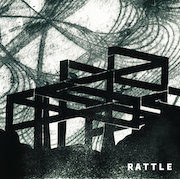In our maximalist, sensory overloading times it’s bewildering to find something as sonically spacious, sparse and economic as a dialog of two drum sets. Being bombarded with information reduces us to passivity and egotism; "We don’t want to assault the listener with too much to listen to, think about and take in, all at once." Rattle’s very manifesto for music allows us breathing and thinking space.
Theresa Wrigley (of Fists) and Katharine Brown (of Kogumaza) began playing together out of genuine curiosity and, as a result, have created a quietly dramatic and loudly intimate record. An honest experiment, this is not some vain exercise in being "experimental". It sounds like they play some awkward version of sonic pictionary, giving each other the most abstract or apparently mundane tasks – silence, or waiting, or the sound of one hand clapping, or rain, or spiritual claustrophobia, or playing hide and seek, or a rattle.
It sounds ominously worthy, but on listening the level of fun is obvious too. Layer upon layer, spoken word singing weaves around carefully crafted atmospheric drum patterns and rudimentary grooves, sounding unpremeditated – spontaneously surreal. Half-hummed words seem to come out freely and arbitrarily from the back of the mind, oohs and aaahs mix with childlike rhymes, apparently surprising even their source. Complex rhythms with unusual time signatures come naturally, crafting rich organic sound with especially effective use of stop-start technique at the heart of band’s subtle dynamic. Songs like the album’s opener, ‘Trainer (get you)’, ear-worm ‘True Picture’, or ‘Stringer Bell’, their cocktail song as they call it, are meant to get you moving and dancing to the beat of a truly unfamiliar configuation of "drummer".
Original as this may be, there will always be hints of influence: minimal atmosphere of lighthearted Scout Nibblet mixed with ludic side of post-punk, tribalism of The Slits reduced to bare bones and Steve Reich inspired technique of gradual build up, though barely, hint at Rattle’s own unique sound. Additional effects are brought by their live sound engineer Mark Spivey (also of Kogumaza), who recorded and mixed the album at The Big Mouse House studio in Nottingham, giving the perfectly poised, ultra-precise drumming of Wrigley and Brown a feeling of largeness contained in a small intimate space and a very real, live sound.
‘Thunder’ is masterful build up of lightweight tension and melodic brilliance. Starting is patiently crafted around the idea of never resolving anticipation and quiet micro bursts of excitement, but the album’s closer ‘Dulling’ brings "blood rush to the extremities/blood rush to the heart", hopefully alluding to more engaging future development.
And when it stops, this music hits you hardest. In silence, you start to understand its clever magic and hypnotic effect. The drum is the most primal instrument of human musical expression – the most ancient language we are deeply connected with. You try to recall those spellbinding rhythms that exist in a place John Cage’s ‘4’33’ opened for us to become aware of the inherent musicality in everything. You try to recall these strangely addictive proto songs, but you start to create your own mental soundscapes from fragmented rhythms of everyday walking, closing the doors, washing the dishes, hitting the keyboard. It makes you aware of how music is built from scratch – that it doesn’t come from some mystical plane, but is deeply and consistently present in everyday life.
There is a magic in silence, repetition and pause that Rattle understand so well. They carve a niche in drumming for thoughtful, egoless expression, and even for lingering hesitation that plays like a tongue-in-cheek nood to cocksure drummer culture. They bring a deceptively simple, unassuming drumming style only Georgia Hubley pulled off so convincingly, betraying expectations of ego fulfillment by not indulging in extravagant freak outs and epic battles. This music alienates that certain kind of musician by design.
Ego is intimidated by simplicity, terrified of silence and flees in horror vacui. Rattle’s drum meditations honor the silence, but mind quickly falls from momentarily zen-like state into ordinary clash of binaries: either/or, this or that, action-response. Rhythm connects the brain’s hemispheres, conscious with unconscious mind. This is tribal music for the introvert, defamiliarising the tribal and merging individual dissonances to achieve something greater, freedom. Rattle’s greatest accomplishment is managing to paint in black and white and produce the effect of colorful variety, to deconstruct the magic of music with subversive simplicity and create something new.


